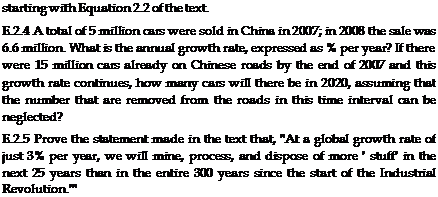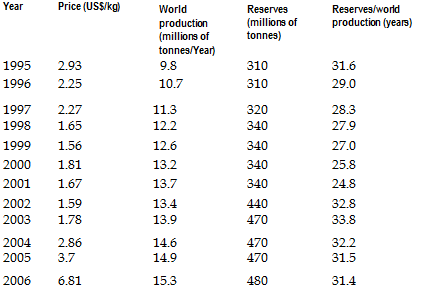Growing global population and prosperity increase the demand for energy and materials. The growth in demand is approximately exponential, meaning that consumption grows at a rate that is proportional to its current value; for most materials it is between 3% and 6% per year. Exponential growth has a number of consequences. One is that consumption doubles every 70/r years, where r is the growth rate in percent per year. It also means that the total amount consumed (the integral of the consumption over time) also doubles in the same time interval.
Most materials are drawn from the minerals of the Earth’s land masses and oceans. The resource base from which they are drawn is large, but it is not infinite. Its magnitude is not easy to estimate so that at any point
in time only a fraction of it, the reserve, is established as accessible and economically viable. Market forces, when they operate properly, ensure that reserves remain adequate, keep supply in line with demand, and ensure that prices remain stable and fair.
The balance between supply and demand can, however, be disrupted. Depletion of the resource base causes scarcity, driving prices up. Reserves that are localized can become vulnerable to cartel action or cut off by local political unrest. Market disruption can be economically damaging, so foreseeing and anticipating it is necessary if stability is to be maintained. Economic forecasting of this sort is based on the tracking of discovery and production rates of material resources and the identification of their sources, flagging those for which a single source dominates world markets as vulnerable.
2.3 Further reading
Alonso, E., Gregory, J., Field, F. and Kirchain, R. (2007), "Material availability and the supply chain: risks, effects and responses", Environmental Science and Technology, Vol. 41, pp. 6649-6656. (An informative analysis of the causes of instability in material price and availability.)
Battery technology: http://en. wikipedia. org/wiki/Rechargeable_battery _Comparison_of_battery_types. (Information on battery efficiencies.)
Chapman, P. F, Roberts, F (1983), "Metal resources and energy", Butterworth’s Monographs in Materials, Butterworth and Co., ISBN 0-408-10801-0.
(A monograph that analyses resource issues, with particular focus on energy and metals.)
McKelvey, V. E. (1973), Technology Review, March/April p. 13. (The original presentation of the McKelvey diagram.)
Shell Petroleum (2007), "How the energy industry works", Silverstone
Communications Ltd., ISBN 978-0-9555409-0-5. (Useful background on energy sources and efficiency.)
USGS (2007), "Mineral Information, Mineral yearbook and Mineral commodity summary", http://minerals. usgs. gov/minerals/pubs/commodity/. (The gold standard information source for global and regional material production, updated annually.)
Wolfe, J. A. (1984), "Mineral resources: a world review", Chapman & Hall, ISBN 0-4122-5190-6. (A survey of the mineral wealth of the world, both for metals and nonmetals, describing their extraction and the economic importance of each.)
2.4 Exercises
E.2.1 Explain the distinction between reserves and the resource base.
E.2.2 The world consumption rate of CFRP is rising at 8% per year. How long does it take to double?
![]()
![]()
 |
 |
 |
E.2.3 Derive the dynamic index:
E.2.7 The following table shows the production rate and the reserves of five metals over a period of 10 years. What has been the growth rate of production? What is that of the reserves? What conclusions can you draw about the criticality of the material?
|
Metal |
Year |
Production rate, tonnes/year |
Reserves, ronnes |
|
Platinum |
2005 |
217 |
71 X 103 |
|
1995 |
145 |
56 X 103 |
|
|
Nickel |
2005 |
1.49 X 106 |
64 X 106 |
|
1995 |
1.04 X 106 |
47 X 106 |
|
|
Lead |
2005 |
3.27 X 106 |
67 X 106 |
|
1995 |
2.71 X 106 |
55 X 106 |
|
|
Copper |
2005 |
15.0 X 106 |
480 X 106 |
|
1995 |
10.0 X 106 |
310 X 106 |
|
|
Cobalt |
2005 |
57.5 X 103 |
7 X 106 |
|
1995 |
22.1 X 103 |
4 X 106 |
E.2.8 Tabulate the annual world production in tonnes/year and the densities (kg/m3) of carbon steel, PE, soft wood, and concrete. (You will find the data in data sheets for these materials in the second part of this book; use an average of the ranges given in the data sheets.) Calculate, for each, the annual world production measured in m3/year. How does the ranking change?
E.2.9 The price of cobalt, copper, and nickel have fluctuated wildly in the past decade. Those of aluminum, magnesium, and iron have remained much more stable. Why? Research this topic by examining uses (is it one of high value-added goods?) and the localization of the producing mines. The USGS Website listed under Further Reading is a good starting point.
E.2.10 The production of zinc over the period 1992-2006 increased at a rate of 3.1% per year. The reserves, over the same period, increased 3.5%. What conclusions about the criticality of zinc supply can you draw from these figures?
E.2.11 The production of platinum, vital for catalysts and catalytic converters, has risen from 145 to 217 tonnes per year over the last 10 years. The ores are highly localized in South Africa, Russia and Canada. The reserves have risen from 56,000 to 71,000 tonnes in the same time
interval. Would you classify platinum as a critical material? Base your judgement on the relative growth rates of production and reserves, and on the dynamic index (equation 2.6) calculated using 2005 data.
E.2.12 Global water consumption has tripled in the last 50 years. What is the growth rate, r%, in consumption assuming exponential growth? By what factor will water consumption increase between 2008 and 2050?
E.2.13 Plot the Annual world production of metals against their Price, using mean values from the data sheets in Chapter 12 of this book. What trend is visible?
Exercises using CES Eco Level 2
E.2.14 Use CES to plot the Annual world production of materials against their Price. What trend is visible?
E.2.15 Make a plot of apparent resource life for materials (the reserves in tonnes divided by the annual production rate in tonnes per year), using the "Advanced" facility in CES to plot the ratio. Which metals have the longest apparent resource life? Why are these apparent lives not a reliable measure of the true life of the mineral?



